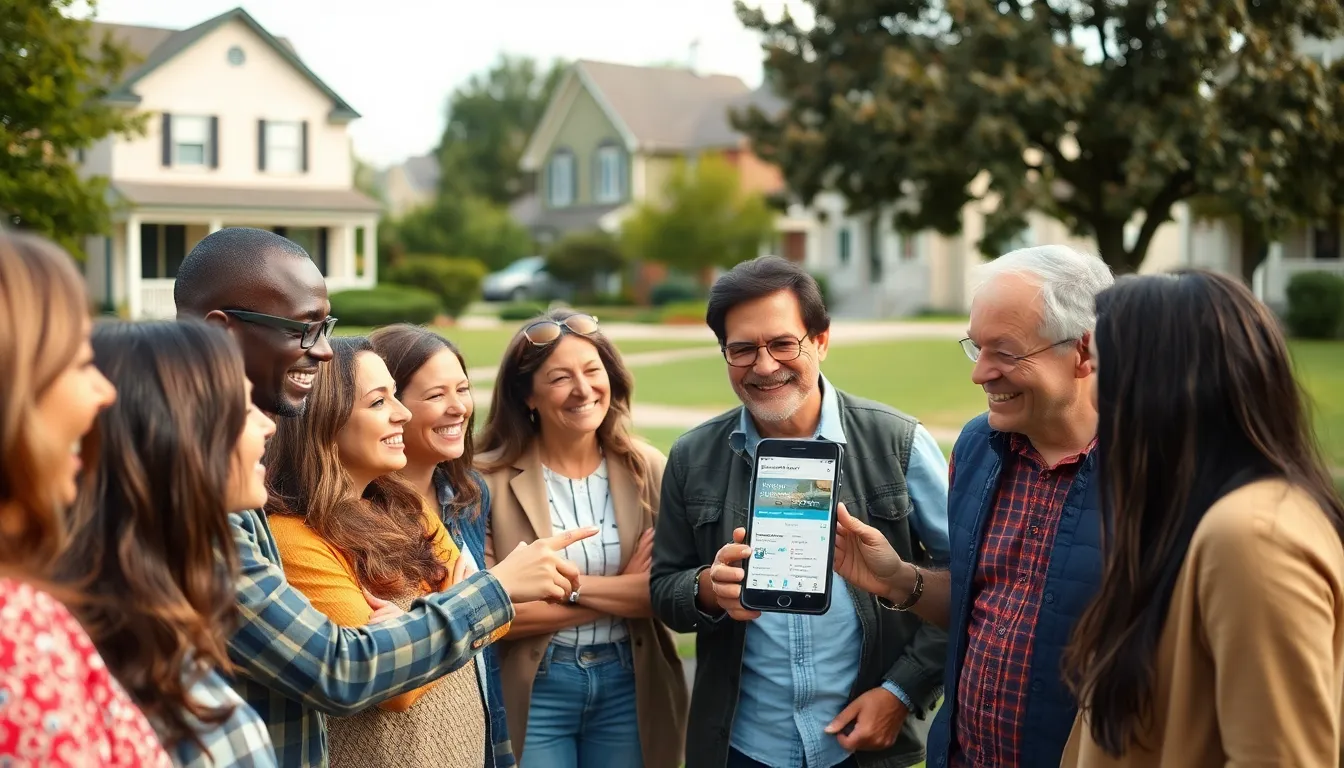Table of Contents
ToggleIn a world where your next-door neighbor might be a cat video enthusiast or a secret avocado toast connoisseur, keeping an eye on the block has never been more entertaining—or necessary. Enter the digital neighborhood watch, where community safety meets modern technology in a way that even your grandma can appreciate. Gone are the days of peering through curtains or whispering over the fence. Now, residents can unite online to share tips, alerts, and maybe even the occasional meme about that suspicious raccoon raiding the trash cans.
Imagine having a virtual neighborhood watch that not only keeps you informed but also brings a sense of camaraderie to your community. With the right tools, neighbors can band together to create a safer environment, all while sharing a laugh or two. So grab your smartphone and get ready to embrace this new age of vigilance—because who said watching out for each other couldn’t be fun?
Overview of Digital Neighborhood Watch
Digital neighborhood watch programs leverage technology to enhance community safety. These programs encourage residents to utilize platforms like social media and specialized apps for sharing alerts and safety tips. By communicating incidents quickly, neighbors can respond effectively to potential threats.
Engagement often increases through the sharing of light-hearted community stories. For instance, posts about a raccoon raiding trash cans not only offer entertainment but also foster connections among residents. Humor helps build relationships and strengthens the neighborhood’s overall bond.
Data suggests that communities with active digital watch programs report a noticeable decrease in crime rates. Residents become more vigilant and informed, with access to real-time information. Surveillance cameras and other smart security systems may also integrate with these platforms, providing additional layers of safety.
Participation requires minimal effort from residents. Guidelines often outline how to report concerns and share useful information, making it simple for everyone to contribute. Digital platforms can facilitate discussions about safety strategies, ensuring that members feel involved and empowered.
Alert systems notify neighbors of suspicious activities or emergencies. Timeliness plays a critical role in these communications, as immediate reports can lead to swift intervention. Community members often feel more secure knowing a network of vigilant neighbors is watching out for them.
The rise of the digital neighborhood watch illustrates a shift in communal responsibility. As technology evolves, so too does the ability for residents to collaborate effectively for a safer environment. This online approach transforms traditional neighborhood watches into dynamic, interactive communities dedicated to mutual safety.
Benefits of Digital Neighborhood Watch

Digital neighborhood watch programs offer substantial advantages for communities. Increased safety and stronger local ties result from using modern technology.
Enhancing Community Safety
Real-time alerts keep residents informed about issues like crimes and suspicious activities. Through social media and dedicated apps, individuals can share relevant safety tips. Timely communication allows prompt responses to incidents, which helps prevent escalation. Data from various studies show active digital community watches correlate with lower crime rates. As more residents engage with these platforms, vigilance increases, creating a deterrent effect on potential offenders. Effective reporting guidelines simplify sharing concerns, ensuring that critical information reaches everyone in the community quickly.
Building Stronger Neighborhood Connections
Shared experiences, including light-hearted moments, strengthen local bonds. Humor and camaraderie thrive as neighbors exchange stories about everyday occurrences like raccoons in the trash. Known incidents promote awareness while bringing residents together. Interaction through digital platforms fosters a sense of belonging and community pride. Participating in discussions builds relationships, allowing for deeper connections among neighbors. Through collaboration, trust forms, leading to a more supportive environment. Engaged residents contribute to a network focused on mutual safety and well-being.
How Digital Neighborhood Watch Works
Digital neighborhood watch operates through modern technology, allowing residents to stay informed and connected about safety concerns. It utilizes various platforms for communication, enhancing community vigilance.
Key Features and Technologies
Features include social media integration and apps designed for crime reporting. Residents share real-time alerts through mobile applications, streamlining communication. Users receive notifications about incidents in the area, ensuring everyone stays updated. Geographic information systems help visualize crime hotspots, aiding prevention efforts. Analytics provide insights into crime patterns, informing proactive measures. These technologies not only improve response times but also create a database for community members to reference.
User Engagement and Participation
Engagement thrives through active participation by local residents. Neighbors post about community events and safety tips, fostering camaraderie. Regular updates encourage continuous interaction, making users feel invested in their community’s safety. Residents also participate in discussions, exchanging experiences and advice on crime prevention. Collaborative efforts strengthen trust among neighbors, promoting a united front against crime. Effective engagement transforms users into vigilant watch members, enhancing overall community safety.
Challenges and Considerations
Digital neighborhood watch initiatives face several challenges that warrant attention. Key issues include privacy concerns and the potential for misinformation, which could undermine community trust.
Privacy and Security Concerns
Residents may hesitate to share information due to privacy issues. Digital platforms often require personal data for registration, raising questions about data protection. Individuals worry about their information being misused, leading to reluctance in participation. To address these concerns, programs must implement robust privacy policies, ensuring data protection for users. Transparency regarding data usage and sharing fosters trust among community members, encouraging more individuals to engage actively. Securing personal data can keep participants informed while protecting their privacy, ultimately enhancing the effectiveness of the neighborhood watch.
Misinformation and Trust Issues
Misinformation can spread rapidly through digital channels, creating confusion and distrust. Instances of false alerts or exaggerated incidents may deter residents from relying on community updates. Building trust becomes essential in addressing this challenge. Establishing clear communication guidelines helps ensure accurate information is shared. Training residents on discerning reliable sources can mitigate the spread of misinformation. Engaging local leaders or law enforcement in communication efforts adds credibility, reinforcing the community’s commitment to safety. Clear messaging and accountability pathways can cultivate trust between residents, making digital neighborhood watches effective in promoting security and collaboration.
Future of Digital Neighborhood Watch
Emerging technologies promise to enhance the effectiveness and engagement of digital neighborhood watches. Artificial intelligence and machine learning can analyze crime data to identify patterns, thereby helping residents anticipate potential threats. Many neighborhood watch programs may incorporate predictive analytics, transforming safety strategies.
Increased adoption of smart home devices is likely to empower residents. Cameras and security systems connected to neighborhood networks enable real-time surveillance. Enhanced connectivity fosters immediate communication, ensuring that incidents receive prompt attention.
Social media platforms will continue to play a critical role. Residents can share alerts and updates through community groups, improving overall awareness. Integration of mobile applications tailored for neighborhood safety offers additional tools, enabling seamless reporting and communication.
Privacy remains a central concern, yet new measures are being implemented. Programs are prioritizing transparent data usage policies to build trust among participants. Engaging local leaders to clarify these policies can offset worries about information misuse.
Community engagement is anticipated to evolve, with virtual town halls paving the way for discussions on safety measures. Residents will likely participate in workshops, learning to utilize digital tools effectively. As involvement grows, so does the sense of belonging and community pride.
Statistical data indicates that these advancements correspond with reduced crime rates in actively engaged neighborhoods. Awareness campaigns highlighting the benefits of digital neighborhood watches are becoming more common. Continuous efforts to combat misinformation will further strengthen these initiatives, enhancing collaboration and safety.
Overall, the future of digital neighborhood watch initiatives looks promising. Empowered communities will remain vigilant, transforming traditional models into innovative, interconnected networks focused on mutual safety and engagement.
Digital neighborhood watch programs represent a significant evolution in community safety. By harnessing technology residents can create a proactive and engaging environment that not only deters crime but also fosters strong connections. The blend of real-time alerts and shared experiences transforms traditional monitoring into a vibrant community effort.
As neighborhoods embrace these digital platforms they pave the way for enhanced communication and collaboration. Addressing privacy concerns and misinformation is crucial for maintaining trust and effectiveness. With the promise of emerging technologies the future of digital neighborhood watches looks bright. Empowered communities will continue to redefine safety and solidarity, making neighborhoods safer and more connected places to live.





